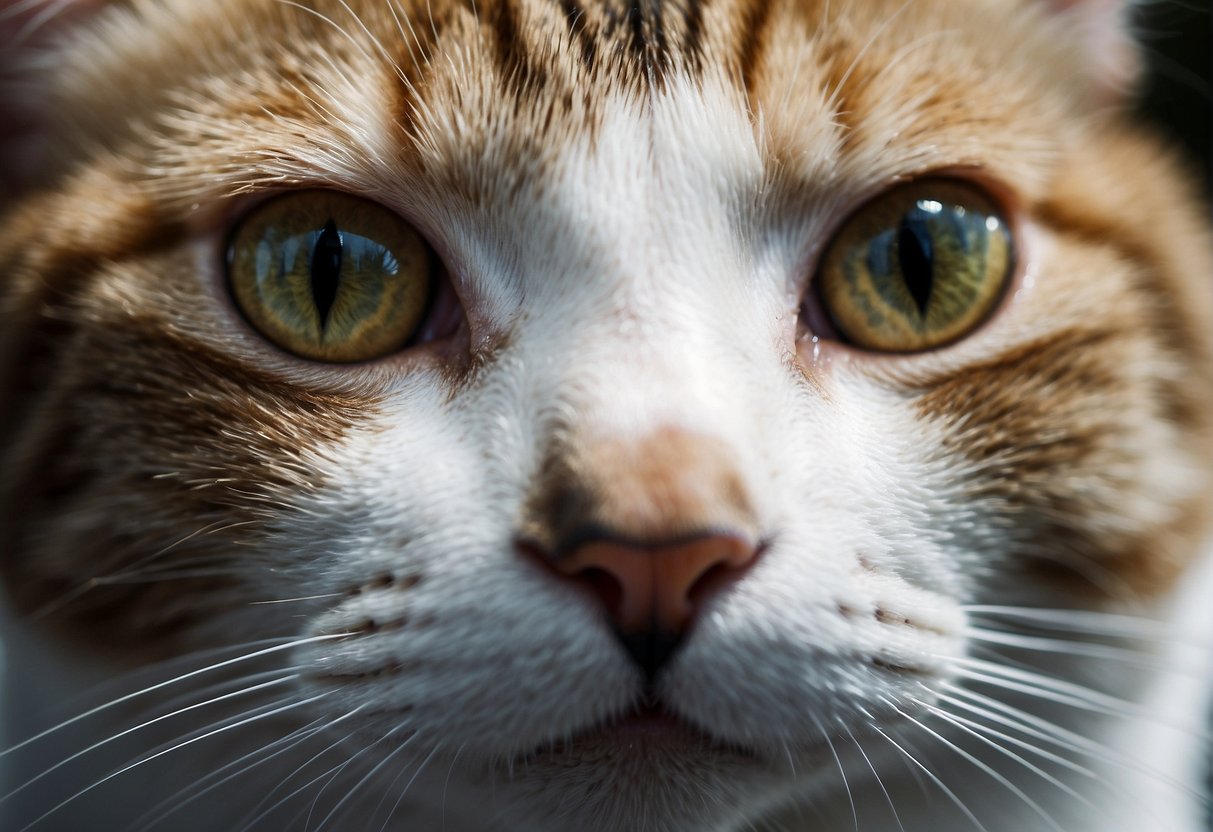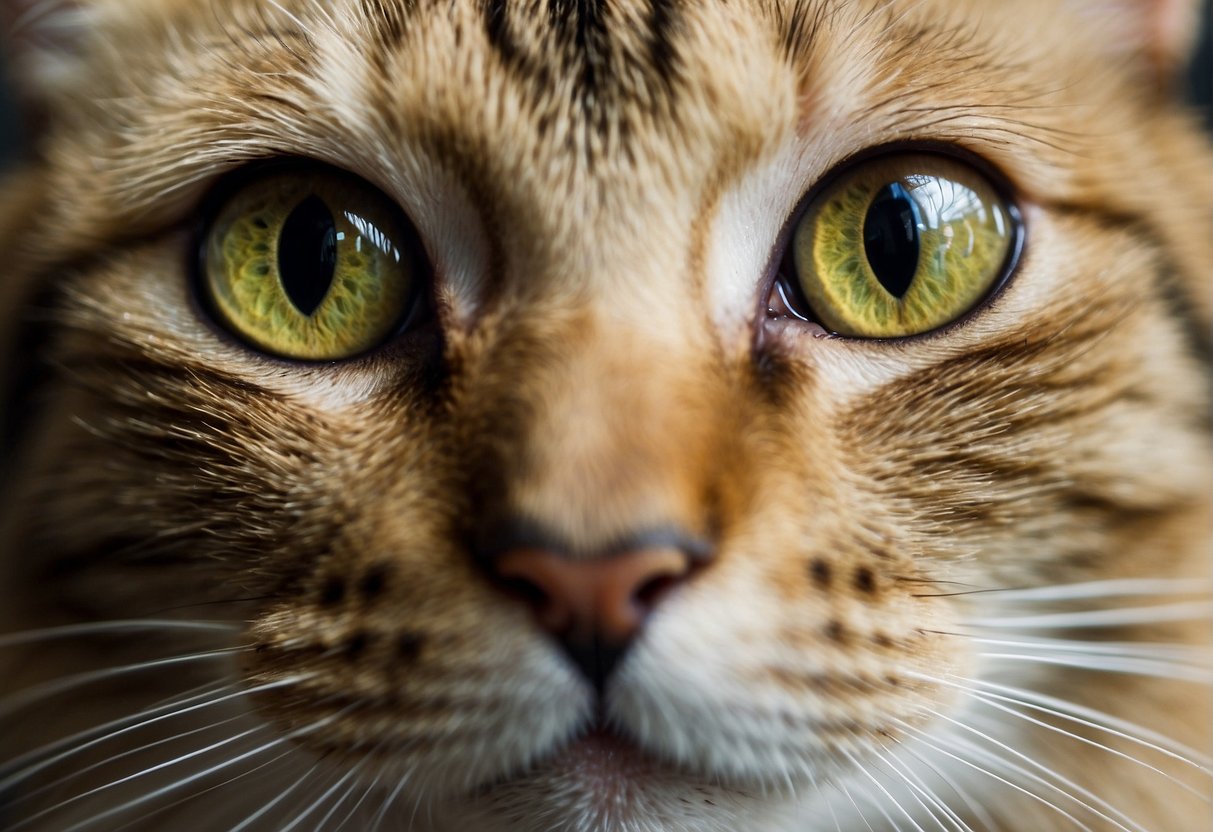Swollen eyes in cats can be quite alarming as they often signal discomfort or an underlying health issue that needs attention. If you notice your cat squinting or if their eye seems red and irritated alongside the swelling, it could indicate a range of potential causes from simple allergies to more serious conditions like infections or trauma.
For example, outdoor cats might occasionally come home with a swollen eye due to a scratch or a dust-up with another neighborhood feline, while indoor cats could develop an allergic reaction to something within the home.

Identifying the cause is key to resolving your cat’s eye issue. Infections, such as those from viruses like feline herpesvirus, commonly manifest with eye-related symptoms including swelling.
Alternatively, environmental allergies or irritants like smoke, dust, or certain cleaning products, often result in similar eye discomfort. Remember, each cat is unique so a thorough vet check-up is crucial to rule out or confirm any suspicions.
As a caring pet owner, your observations are invaluable. Monitoring your cat’s behavior for signs of distress or discomfort—like pawing at their eye, excessive tearing, or avoiding bright light—can provide helpful clues when consulting with your vet.
Recognizing Symptoms

When your cat has a swollen eye, it’s crucial to promptly identify the symptoms to ensure their comfort and health. Swelling can indicate a range of issues, from infections to allergies, and recognizing the signs is the first step towards getting your feline friend the care they need.
Common Signs
- Redness: The white part of your cat’s eye may appear more reddish-pink than usual, indicating irritation.
- Pain: Your cat might express discomfort through increased blinking or squinting.
- Watery eyes: Excessive tearing or discharge could be a sign that something is irritating the eye.
- Pawing at the Eye: When experiencing discomfort, cats often try to relieve irritation by pawing at their eyes.
- Sensitivity to Light: Notice if your cat is avoiding bright areas, which can suggest sensitivity due to inflammation.
- Impaired Vision: Watch for any hesitation or clumsiness when your cat navigates familiar environments, which might signal vision issues.
Potential Complications
- Constant Squinting or Blinking: Persistent squinting or blinking can suggest a more severe problem that requires prompt veterinary attention.
- Behavior Change: If discomfort leads to a noticeable change in behavior, such as aggression or lethargy, it may be time to consult a vet.
- Chronic Discomfort: Ongoing signs of irritation can lead to stress and negatively impact your cat’s overall well-being.
- Secondary Infections: Untreated eye conditions can lead to further infections which complicate initial symptoms and require more complex treatments.
Understanding Causes
When you notice your cat’s eye is swollen, there are several potential causes you may consider. These range from infections to physical injuries and environmental triggers that could be affecting your feline friend’s eye health.
Infection and Disease
Infections are often the primary suspects when it comes to eye swelling. Viral infections, such as feline herpesvirus (FHV-1), can lead to inflammation and discharge. It’s similar to the human cold sore virus and just as contagious among cats.
Another culprit could be bacterial infections, often secondary to viral ones, requiring antibiotic treatment. Diseases like feline leukemia virus may also weaken the immune system, making your cat more susceptible to eye issues.
Physical Injury or Trauma
Swelling can also be related to physical injury or trauma. A scratch or a bump can lead to inflammation or even a corneal ulcer. Have you ever seen your cat’s fur flying after a skirmish with their feline housemate? Sometimes those encounters result in eye injuries.
Additionally, entropion, a condition where the eyelid rolls inward, can cause the eyelashes to irritate the eye, leading to swelling.
Environmental Factors
Lastly, environmental factors can contribute to eye swelling. Your cat may have an allergy to pollen, dust, or certain foods manifesting as swollen, watery eyes due to the immune system’s reaction to these allergens.
Sometimes, an outdoor adventure goes awry, and a foreign body like a plant awn might find its way into your cat’s eye, causing irritation. Accidental exposure to household chemicals or irritants such as smoke and perfumes could also be responsible for swelling and redness.
Immediate Care and Treatment
When you notice your cat’s eye is swollen, prompt action can prevent further discomfort or damage. Begin with gentle home care and then seek professional veterinary assistance to address underlying health concerns.
First Aid and Home Care
Initially, you can help your cat by minimizing their eye discomfort with careful home treatment:
- Examine the eye: Carefully assess for any obvious foreign bodies or injuries.
- Warm Compress: Apply a warm compress to the affected eye for a few minutes to soothe irritation.
- Keep it clean: If there is discharge, use a clean, damp cloth to gently wipe it away.
- Prevent further injury: Consider an Elizabethan collar to stop your cat from scratching the eye.
Professional Veterinary Care
Your vet will conduct a thorough exam, which may include:
- Tonometry: To measure the pressure inside the eye and check for glaucoma.
- Schirmer Tear Test: To assess tear production and rule out dry eye conditions.
- Examination for corneal ulcers or deeper injuries: Using special dyes and lights.
Depending on the diagnosis, treatment may involve:
- Medication: Specific eye drops or ointments to combat infection or inflammation.
- Antibiotics: If a bacterial infection is present, oral antibiotics or antibiotic eye drops may be prescribed.
- Anti-Inflammatories: To reduce swelling and discomfort.
Prevention and Maintenance
Maintaining your cat’s eye health starts with regular care and attention to their living environment. Prevention of eye issues, like conjunctivitis or scratches, can often be managed with a few simple strategies:
- Keep Vaccinations Up to Date: Feline herpes virus, a common cause of eye infections, can be curbed with proper vaccinations. Speak with your vet about maintaining a vaccination schedule.
- Regular Vet Check-ups: Annual exams can catch early signs of eye disorders, including eye tumors or complications before they become severe.
- Maintain a Safe Environment: Reduce the risk of scratches and trauma by keeping your cat’s play area free from sharp objects.
Daily Inspections are key. Look out for:
- Redness
- Discharge
- Any sign of a scratch
These could indicate infections, whether bacterial or viral. If you notice abnormal discharge or a scratched cornea, a vet visit is in order. A veterinary ophthalmologist may use a fluorescein stain to detect corneal injuries.
To safeguard against the spread of infection:
- Isolate Affected Cats: If you have multiple pets, separate the one with eye issues.
- Wash Your Hands: Before and after touching your cat’s eyes, clean your hands to prevent spreading infections.

My name is James, and welcome to FAQCats!
Along with our team of cat owners, expert pet enthusiasts, and pet professionals, we aim to write engaging helpful, engaging content about cats. At FAQCats we strive to provide content that’s accurate and fun to read. Our team writes about everything related to cats; even the most complex of topics. Through extensive research and caring for our own fur-pals, we’re able to provide something cat owners worldwide will love. Have a look around, and leave us feedback anytime!

